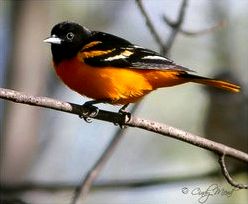 Traditional, shade-grown coffee plantations harbor a diversity of several taxa — orchids, insects, and mammals, for example. But it is the research that shown the value of shade coffee plantations to wild wild birds that caught the eye in the public, and very kick-started cooler areas-grown coffee movement.
Traditional, shade-grown coffee plantations harbor a diversity of several taxa — orchids, insects, and mammals, for example. But it is the research that shown the value of shade coffee plantations to wild wild birds that caught the eye in the public, and very kick-started cooler areas-grown coffee movement.
Over the past handful of decades, scientists observed extended-term declines in several kinds of Neotropical migrants — about 200 kinds of wild wild birds that breed within the U . s . States but winter south in the Tropic of Cancer. Researchers were motivated to check out the entire existence cycle of individuals species. The ecosystem in the migrants by themselves nesting grounds inside the U . s . States was fairly well-studied, but additional information was needed concerning the needs of those wild wild birds which spend a lot of their year in-transit or possibly within the tropics. Looking for solutions, researchers looked for the wintering parts of “our” breeding wild wild birds.
Using the much habitat inside the " " New World " " tropics being removed for agriculture the value of coffee plantations to wintering U . s . States migrants (additionally to resident species) soon increased to get apparent. The multi-layered plant existence of traditional or rustic shade-grown coffee plantations provides food and canopy for wild wild birds that’s sometimes similar to native forest. In locations that farming has replaced natural habitat with stark pastureland and row crops, coffee farms are from time to time really the only quality habitat available.
The Smithsonian Migratory Bird Center’s guide, “Why Migratory Wild wild birds are Crazy deeply in love with Coffee,” notes:
Inside the regions most heavily employed by migratory wild wild birds — Mesoamerica, the islands islands, and Colombia– coffee plantation “forests” cover 2.seven million hectares, or up to 50 % in the permanent cropland.
In southern Mexico, coffee plantations cover a location over half the length of virtually all of the moist tropical forest reserves, offering critical woodland habitat in mid-elevation locations that with no large reserves can be found.
Beneath the category “Research on coffee growing,” you will find summaries of the couple of from the research on bird diversity on coffee plantations. Some details gleaned using this research include:
- Almost all bird species in shade coffee plantations are feeding inside the shaded overstory, from the coffee. The coffee shrubs themselves offer handful of sources. Because of this sun coffee monocultures don’t support a diversity of untamed wild birds.
- The requirement for coffee farms depends largely upon the range of their canopy: both the quantity of different species as well as the structural complexity in the canopy.
- Invertebrates, fruit, and nectar are the key food sources for wild wild birds in coffee plantations, so coffee farms are particularly crucial that you bird species that prey on these sources.
- Migratory wild wild birds tend to be flexible inside their habitat needs, and fare best in coffee plantations than many resident species, for attentive to habitat changes.
- Usage of coffee plantations by migrant wild wild birds is very periodic. Clearly, U . s . States migrants are simply within the tropics during fall and spring migration plus winter. However, even during wintertime some migrants, particularly people who prey on nectar or fruit, possess a inclination to increase in number from early to late winter in plantations where these sources are available. Three U . s . States migrants are strongly connected while using flowering of Inga trees (which are generally grown in shade coffee canopy): Baltimore Oriole (above), Orchard Oriole, and Tennessee Warbler. This can be a report on U . s . States species designed to use coffee plantations.
Bird diversity in rustic or heavy shade plantations sometimes rivals individuals of natural forests. These plantations in addition have a significantly greater bird diversity (additionally to some diversity of other species) when compared with sun coffee plantations. Shade coffee plantations offer important refuges for species in locations that natural settings are quickly being changed into agriculture.
You should know the different amounts of shade that coffee is grown, because some growing methods even if technically “shade grown,” aren’t beneficial to wild wild birds.
All of the the eco/bird-friendly, sustainable coffee movement which is connected certifications is within the paper “In pursuit of sustainability: learning the coffee sector” by Robert Grain in the Smithsonian Migratory Bird Center. Annotated PDF here.
Baltimore Oriole photo by Cindy Mead of Woodsong Nature Photography coupled with permission.

Resourse: http://coffeehabitat.com/2006/02/wild wild birds_and_coffe/
37 Percent of Birds Need Conservation Care
Video COMMENTS:
mundo de todos kings: ,(
mundo de todos kings: nooooo
Angela Ziegler: Blame China they're complete chodes when is comes to pollution.
JB Bros: (._.) Dis is Jerald, He Supports Wild Life.. Because he is Wild life. Be Smart Like Jerald, Before you go extinct. \n /I\ \n /\
Random Facts: No bird wants your crap unless their hunting for food which they always are and the only thing they can find are trash 😒
Debbie Mcclure: Ppl should be ashamed for contaminating these birds habitats as well as these beautiful places God gave us to look at, smh
Brendan: It's not that hard to recycle, people!\nShame on you if you have recycling trucks able to come and pick up your recycling bins yet you don't put anything in it.
Vanillarhino: Birds are so pretty!
Alexandra Marquez: 😘
Chokaj 22: First